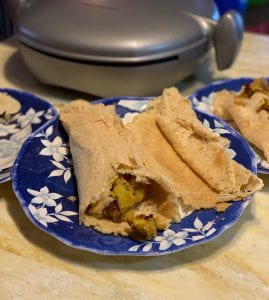To explore the intersection between Indian food and culture, I decided to try my hand at making a classic South Indian dish, the Masala Dosa. Luckily for me, my family randomly has a DosaMaker at home, so it made the perfect quarantine lunch. Although it took a few bad batches to end up with a satisfactory dosa, it was worth the effort. A dosa, or dosaka, can be made without a DosaMaker by using a pan on the stove. Such a process should lead to comparable results, but I did not attempt to do so.
The recipe requires several Indian staples including urad dal, mustard seeds, turmeric, asafetida and cumin seeds. What was surprisingly difficult was the effort it took to get the dosa cooked just right. After reading all the comparisons to crepes, I was surprised at the process and results. So, what exactly is a dosa?
According to Colleen Taylor Sen’s Feasts and Fasts: A History of Food in India, ancestral foods similar to the dosa have been around since the 1000’s BCE. Evidence of Proto-Dravidian society points to the people’s diets consisting in part of flour mixed with milk. By the 600’s CE this food had become the Dhosika. In modern day, this large Indian crepe is called the dosaand it is a staple of South Indian cuisine.
Although we cannot pinpoint the exact date the dosa was created, it has since become a staple of Indian cuisine. We see its presence in even the very oldest of Indian cookbooks, named the Manasollasa or Delights of the Mind, which is a 12th century Sanskrit cookbook of King Someshvara III’s. This 1,820-verse book contains receipts for the dosaka.
One can find a dosa just about anywhere in South India, either served with vegetables and other foods inside them, such as the Masala Dosa I made, or with side dishes. The Masala Dosa with potatoes and spices inside is the most popular way to eat a dosa. It is usually served hot alongside other foods. However, the dosa is a very versatile food, and there are hundreds of ingredient variations based on one’s individual food preferences.
The dosa was light and airy. Although in literature it is often referred to as crepe-like or called an Indian Crepe, I find that comparison to only be accurate in describing its texture, thinness and color. Unlike the crepe’s sweet and savory batter, the tangy and crispy dosa is made of fermented lentils and rice. The Masala Dosa is then filled with potatoes, spices, and onions, making it more of a lunch food rather than a crepe or a pancake.
The dosa is a delightful dish even for those with very narrow taste palates. Because there are many ways to make the dosa, it can satisfy everyone regardless of their taste. A simple google search will reveal thousands of possible recipes. However, learn from my mistakes and try your hand at making a dosa first before experimenting with additions.
—
Amit, Dassana, et al. “Masala Dosa (with Savory Potato Filling): Hotel Style Masala Dosa.” Dassana Amit Recipes, 28 May 2020, www.vegrecipesofindia.com/masala-dosa-recipe-how-to-make-masala-dosa-recipe/.
LHI Team. “What Indians Ate in the 12thCentury,” Live History of India, 30 November 2020,
Sen, Colleen Taylor. Feasts and Fasts: A History of Food in India., 2015.
Shrigondekar, Gajanan. “Mansaollasa of King Somesvara.” RBSI – Digital Rare Book: Manasollasa of King Somesvara Edited by Gajanan K. Shrigondekar Published by Oriental Institute, Baroda – 1939 Volume 2 Read Book Online: Http://Bit.ly/2xqh9dr Download Pdf Book, Oriental Institute, Baroda, 1939, www.rarebooksocietyofindia.org/postDetail.php?id=196174216674_10157093362146675.


